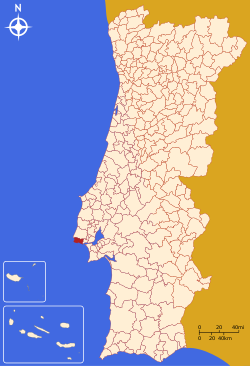Cascais
| Cascais | |||
|---|---|---|---|
| Municipality | |||

Clouds reflected off the sunset in the Bay of Cascais, with the city of Cascais
|
|||
|
|||
 |
|||
| Coordinates: 38°42′N 9°25′W / 38.700°N 9.417°WCoordinates: 38°42′N 9°25′W / 38.700°N 9.417°W | |||
| Country |
|
||
| Region | Lisbon | ||
| Subregion | Grande Lisboa | ||
| Metropolitan area | Lisbon | ||
| District | Lisbon | ||
| Parishes | 4 | ||
| Government | |||
| • President | Carlos Carreiras (PSD-CDS) | ||
| Area | |||
| • Total | 97.40 km2 (37.61 sq mi) | ||
| Population (2011) | |||
| • Total | 206,479 | ||
| • Density | 2,100/km2 (5,500/sq mi) | ||
| Time zone | WET/WEST (UTC+0/+1) | ||
| Postal code | 2750 | ||
| Area code | 214 | ||
| Patron | Santo António | ||
| Website | http://www.cm-cascais.pt | ||
Cascais (Portuguese pronunciation: [kɐʃˈkajʃ]) is a coastal town and a municipality in Portugal, 30 kilometres (19 miles) west of Lisbon. It is a cosmopolitan suburb of the Portuguese capital and one of the richest municipalities in Portugal. The population in 2011 was 206,479, in an area of 97.40 square kilometres (37.61 square miles). The former fishing village gained fame as a resort for Portugal's royal family in the late 19th century and early 20th century. Nowadays, it is a popular vacation spot for both Portuguese and foreign tourists.
It is located on the Estoril Coast (also known as the Portuguese Riviera), in the Greater Lisbon subregion. It has an airport for general aviation serving the Lisbon Region in Tires (S. Domingos de Rana), the Cascais Aerodrome, that also offers domestic scheduled flights by Aero VIP.
Human settlement of the territory today known as Cascais dates to the late Paleolithic, as indicated by remnants encountered in the north of Talaíde, in Alto do Cabecinho (Tires) and south of Moinhos do Cabreiro. It was during the Neolithic that permanent settlements were established in the region, their inhabitants utilizing the natural grottoes (such as the Poço Velho in Cascais) and artificial shelters (like those in Alapraia or São Pedro) to deposit their dead. The bodies were buried along with offerings, a practice that continued to the Chalcolithic.
Roman interventions in the area occurred with the settlement of the villae of Freiria (today São Domingos de Rana) and Casais Velhos (Charneca), evidence for which includes a group of ten tanks discovered along the Rua Marques Leal Pancada in Cascais, which was the location of a salting factory for fish. Roman dominion over the territory also influenced place names in the region, as was the case with the word "Caparide" (from the Latin capparis, meaning "caper"), as well as several inscriptions associated with funerary graves.
...
Wikipedia


